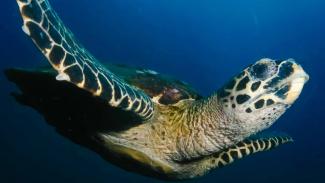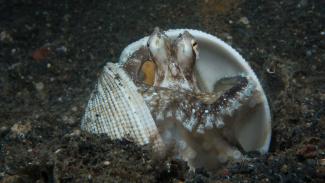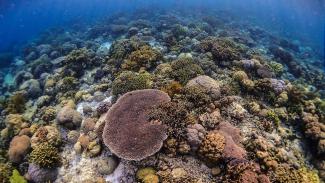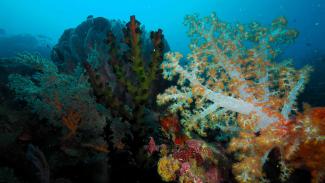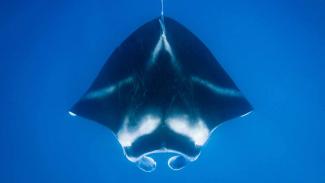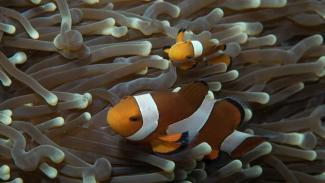Outstanding diving and wildlife opportunities for the more adventurous diver
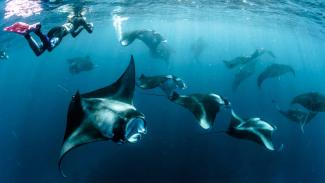
Sebastian Pena Lambarri
On the east coast of Kalimantan, a little south from the world famous Sipadan area, are more equally impressive, but less well-known islands & reefs.
These difficult to reach dive sites are now beginning to open up to divers - and the intrepid travelers who make it this far will not be disappointed.
Just like the Sipadan area, East Kalimantan has a lovely combination of big fish dives and critter dives. The area is most famous for its Manta Rays, which can congregate here in huge numbers. There is also a very unusual lake dive.
Highlights
Best diving spots
The star of the show here is Sangalaki - a tiny island surrounded by a gentle sloping reef. The reef itself is interesting, but the real draw card are the numerous Manta Rays that feed on the plankton rich waters surrounding the island. There is no need to go deep here to find the Mantas. They normally swim just below the surface, so spending the whole dive admiring these majestic creatures is normally no problem. Most of the Mantas are black and white and around 3-4m in size, but the area also has a few, very unusual pure black Mantas, reaching 6m in size.
Maratua, also known as Big Fish Country, is another splendid site. The oddly shaped island creates a large lagoon with outer walls droping off into oblivion. As its nick-name suggests - big fish are regular visitors. Huge schools of Barracuda often engulf divers, Trevally & Tuna hunt all around and Sharks are not uncommon. Look above, and you may be lucky enough to see a school of Eagle Rays cruising by. Large Bull Rays are also seen here, along with occasional Manta sightings.
The islands off East Kalimantan are not all about big fish though. Just like the more famous sites of Sipadan to the north, there are plenty of macro delights to be found. Nestled in the lagoon created by the unusual Maratua Island, tiny Nabucco Island has Frogfish, Mandarinfish and many other weird & wonderful creatures.
Derawan Island, while not blessed with great visibility, is blessed with a wonderful diversity of critters with Flambouyant Cuttlefish, Blue-ringed Octopus, Leaf Scorpionfish, Ghost Pipefish, Ribbon Eels and Seahorses making a home here. The island, which has one resort, is also a nesting ground for Green Turtles and they are often seen swimming along the reef. Nurse Sharks & Leopard Sharks can be spotted resting on the sand during the day.
This coast also has one of the world’s most unusual dives - Jellyfish Lake. About 20,000 years ago, techtonic activity created an uplift of rock, now known as Kakaban Island. This process also completely trapped a large area of seawater in the middle of the island, cutting off the marine life inside from all outside influences and allowing it to follow its own evolutionary path.
Now, the lake is home hundreds of stingless jellyfish of four different species, plus unique sponges, tunicates, crustaceans & anemones. The lake also has its own unique species of sea snake. If you want to dive somewhere really unusual, this lake could well be it.
On the outer edge of the island are some good dive sites too. Barracuda Point, Kakaban Drop-off & Tanjung Point are all great drift dives with plenty of pelagics. There is also a deep cave here, but it is only recommended for very experienced divers with the necessary training and safety equipment.
When to dive
The East Kalimantan region has similar seasons to Sipadan, with the best diving from March through to October. January & February bring the most challenging conditions for scuba diving.
Getting there
To reach the dive resorts of Maratua and the Derawan Islands, take a flight from either Jakarta or Singapore to Balikpapan, then an onward flight to Berau. Catching an early morning flight from Jakarta or Singapore enables you to make the connection to Berau the same day.
From Berau, it is around an hour's boat ride to the islands. Alternatively, it is possible to fly or take a boat from Tarakan in Sabah, Malaysia.
Activities
These islands are fairly remote and the main activities away from the reefs are nature-watching and simply relaxing.
Resort and liveaboard options
This is a remote location, with Maratua Atoll the main focus of the dive resorts. Expect fairly simple accomodation, but in a magical setting with outstanding diving on your doorstep.
Some resorts operate on set arrival and departure days only to allow guests to save money on boat transfer costs out to the resorts.
Some liveaboards are beginning to pay attention to this region, offering occasional itineraries for eager divers.
We recommend the team at Liveaboard.com to find your perfect Kalimantan liveaboard adventure.
Diving adventures can be extended with a visit to the Orangutan Sanctuary back on mainland Borneo.
How to dive Kalimantan
Maratua has some good dive resorts such as Maratua Paradise Resort and Nabucco Island Resort. However liveaboards also now visit this region and may be the better option to fully explore the area.
With the widest choice of liveaboards available and a best price guarantee, we recommend to book your liveaboard adventure with the team at liveaboard.com.
The White Manta visits the region between June and September each year and is a superbly rated modern liveaboard. She tends to offer 6 night itineraries.
The elegant Ondina is another recommended option, focusing on this area in similar months and offering slightly longer 8 night itineraries. Renovated in 2014, she is built in a traditional Phinisi style.
The Ambai is another outstanding liveaboard visiting this area annually from late May through to September and offers itinerary options from 9 to 11 nights.
Maratua Snapshot
- When to go: High season is from April through to October, but can be dived throughout the year from resort with the exception of January. Liveaboards tend to visit the region from late May through to September.
- Marine life highlights: Manta Rays, Sharks, Pelagics.
- How to reach: Fly to Berau via Balikpapan.
- Prices guide: Accommodation starts from around USD50 per night, plus diving and transfers from Berau (set days only). Liveaboards begin from around USD240 per night.


